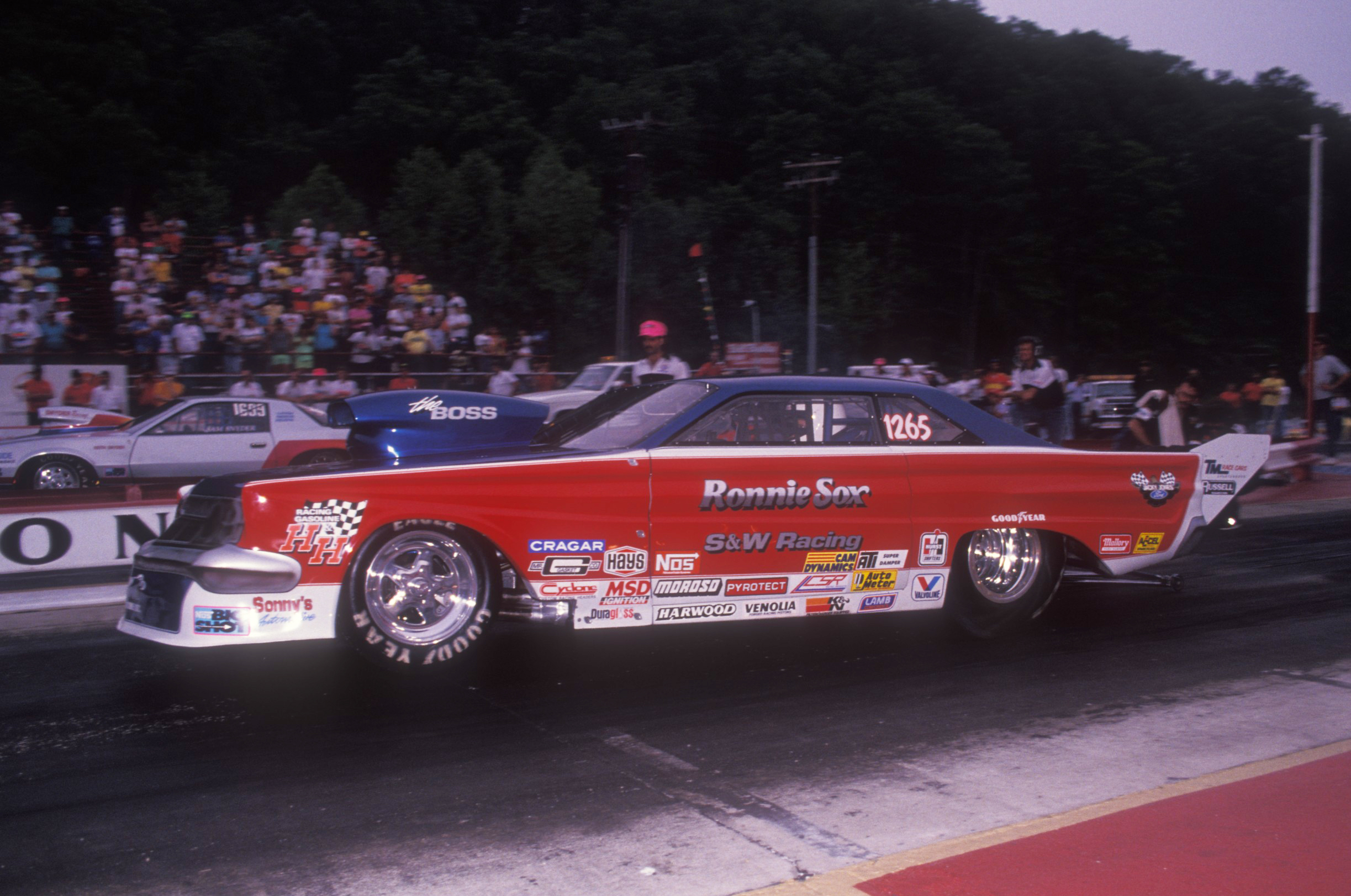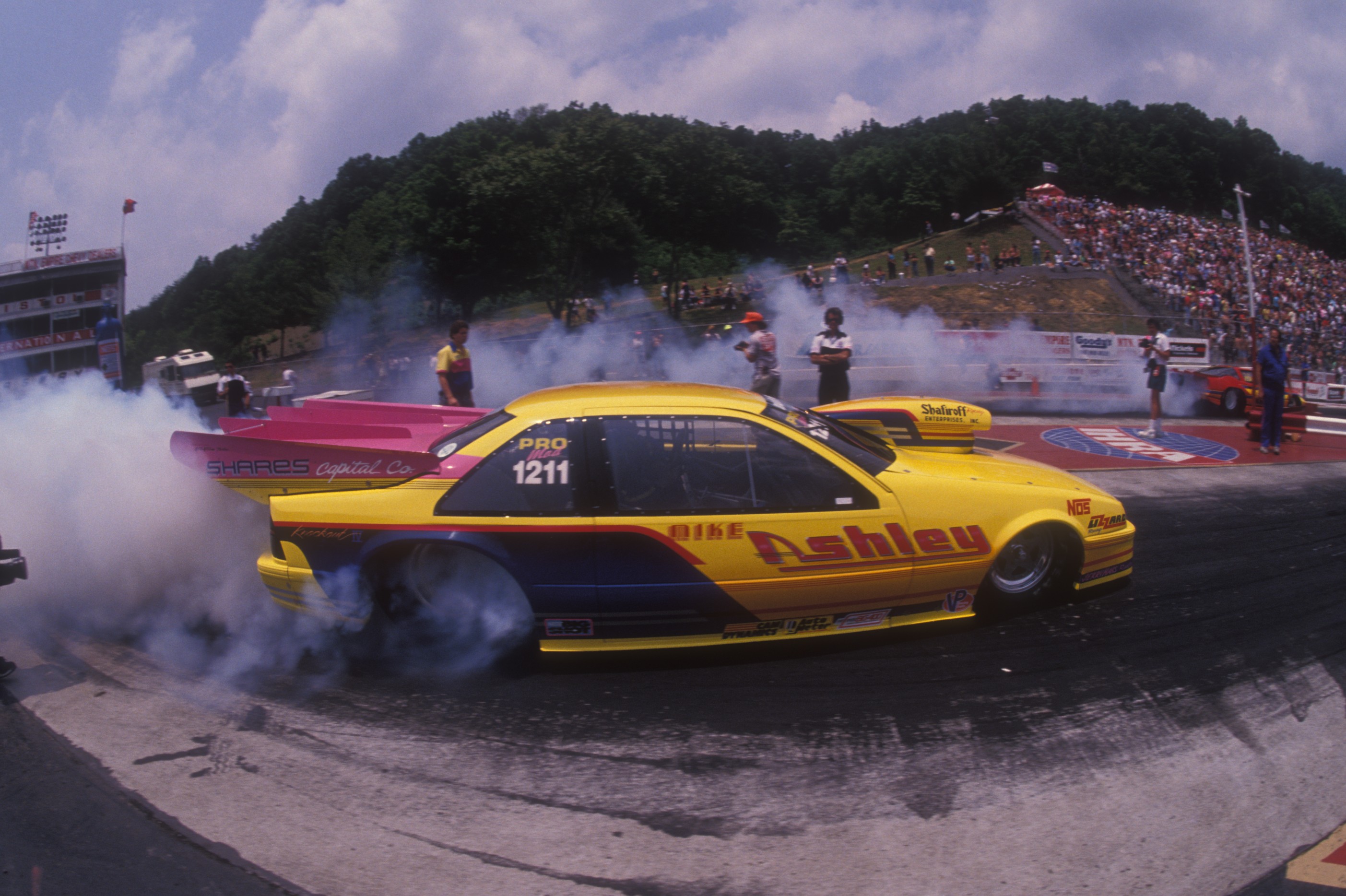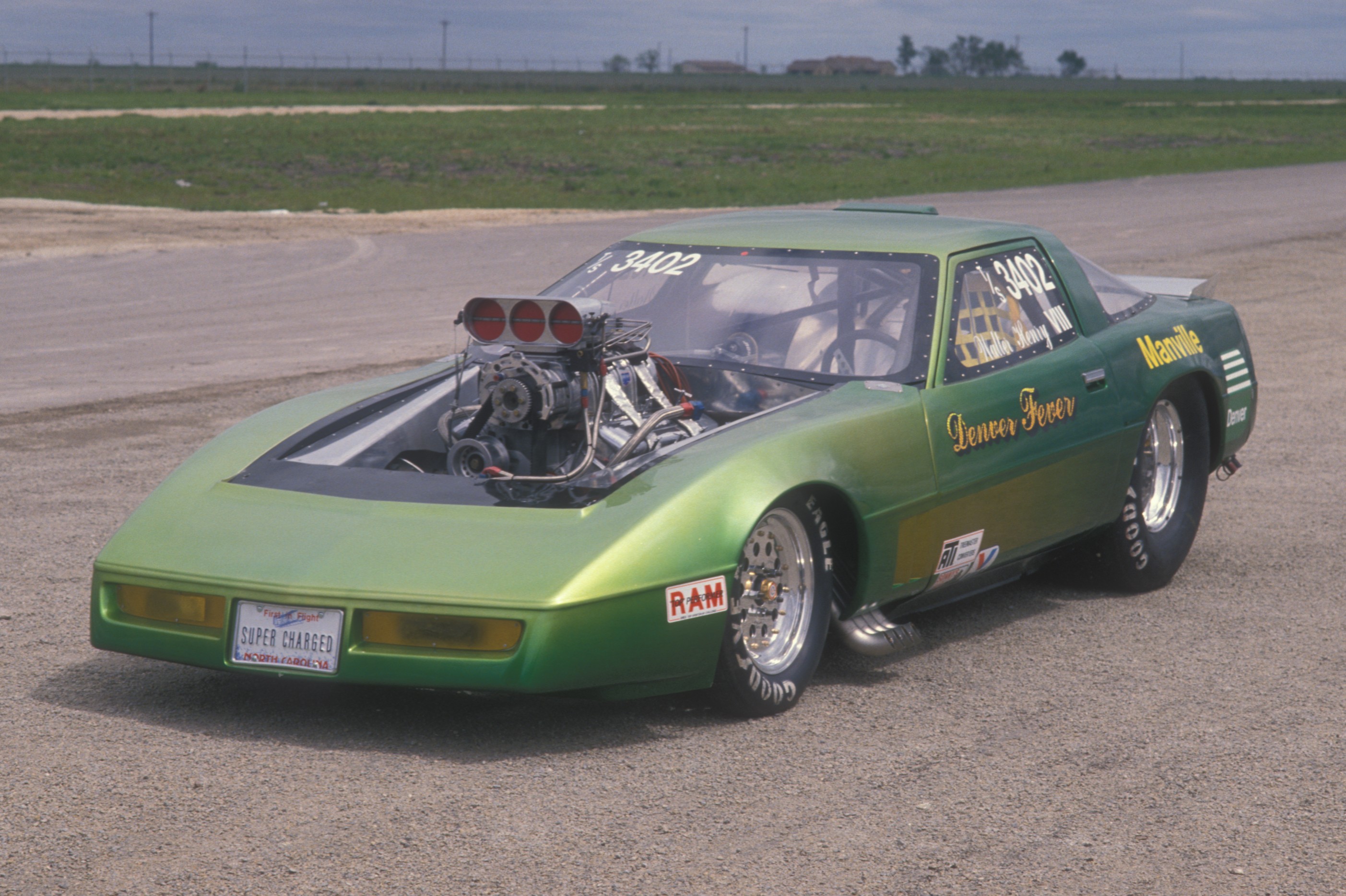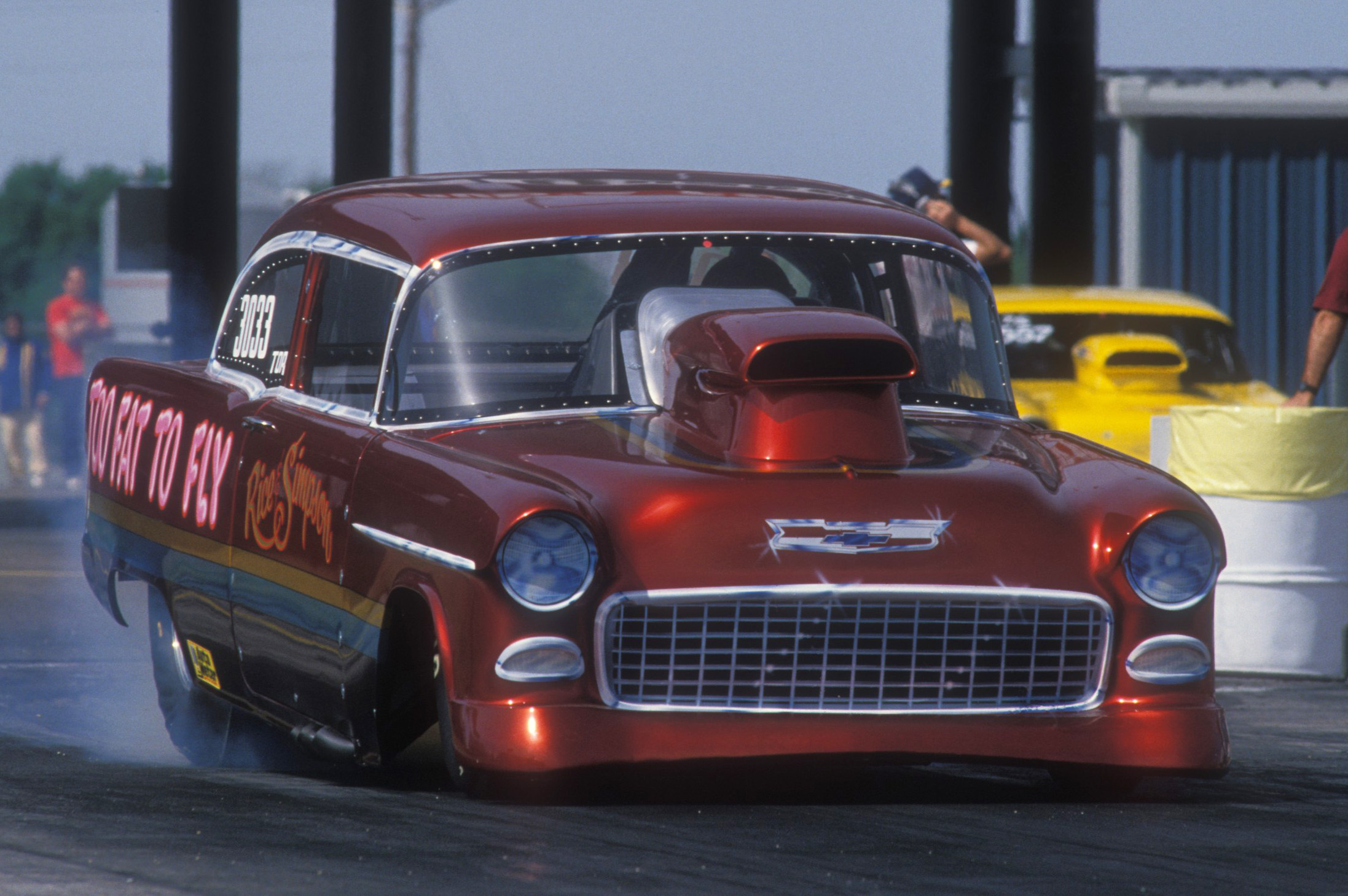PRO MODIFIED MIGHT HAVE BEEN CULTIVATED ELSEWHERE, BUT IT WAS BORN IN BRISTOL, TENN


Make no mistake about it. Pro Modified might have been cultivated elsewhere, but it was born in Bristol, Tenn.
Bristol is where the IHRA headquarters were located in 1989, right on the grounds of its flagship race track, Thunder Valley Dragway, now known today as Bristol Dragway.
As stated earlier, the groundswell of popularity for cars equipped with Pro Stock style chassis, big engines, and heaping amounts of nitrous oxide were the rage in the Carolinas. However, they were not all late model Camaros, Firebirds, or Thunderbirds in this case. They were often cloaked in a 1955 Chevy body or a ’41 Willys shell.
It was like a Mountain Motor Pro Stocker, but clearly not like one.
More and more racers were building these style doorslammers to run a bracket class called Top Sportsman, which had already gone through three name changes since its IHRA inception in 1979. It started as Pro Street, then Street Rod and Quick Rod before the current name. Even then, it was nothing more than a spinoff of the old AHRA Top Comp eliminator.
More so, were they quick, fast, and unique; these fast doorslammers were entertaining.
Many eighth-mile tracks, especially those in the Carolinas throughout the Southeastern United States, booked in the IHRA’s mountain motor Pro Stockers and Alcohol Funny Cars for match races. When the local races began to run quicker and put on a better show than those who they were booking in for the show, some of the promoters, namely the ones around Charlotte (NC) and Orangeburg (SC), began to offer these teams guaranteed money to withdraw from the bracket race competition and race against a similarly prepared entry.
The more is better philosophy led these track operators to offer robust purses for a field of eight cars that many of the major series didn’t know what to do with.

Most of these racers had competed at small backwoods venues such as Shuffletown Dragway (Charlotte) and Orangeburg Dragway (SC), where, after years of bracket racing, they got to run heads-up on a pro-tree and no longer had to pay an entry fee. Instead, they were getting paid.
Racers like Michael Martin, with his nitrous-injected late-model Corvette, and Blake Wiggins rolled to the line with fans who had watched them race as Modified Eliminator competitors.
These events were mainly at Orangeburg Dragway (credited as the first of the Quick Eight shows) and Shuffletown Dragway, and immediately, they began to pack the tracks with more than just race cars. Suddenly, folks who had stayed away from their local tracks because of their disdain for bracket racing were gladly plunking $10 and $20 bills to watch the locals run heads-up and with no breakouts.
On Sunday afternoons, you could see the Top Sportsman whos-who in an eight-car field of Martin, Wiggins, Carpenter, Ed Hoover, Sonny Tindal, Walter Henry, Ed Wilson, Thomas Jackson, Tommy Mauney, and a score of others.
Nitrous oxide icon Mike Thermos, who operated primarily nationally with his California-based Nitrous Oxide Systems [referred to by many of the street racing crowd as “naaaws,” began to have visions of taking this style of racing to the national markets. Many of the Carolina boys were his customers.
Thermos proposed the idea to Ted Jones, then the Vice-President of the IHRA, for a special four-car shootout of the top four doorslammer qualifiers in Top Sportsman. The first of the Quick Four events came in 1987 at the IHRA Northern Nationals in Milan, Michigan, and then later at the season-ending
Jones initially wasn’t receptive to the idea, Thermos pointed out.
“I had just about given up on doing anything,” Thermos explained. “I had flown out several times to talk to Ted Jones, and for one reason or another, those meetings never happened. I wanted to do a Quick Eight for the Top Sportsman cars on Saturday night. Finally, he told me I could do the Quick 4 thing in Milan. Ted asked me if I was going to pay them, and I said I’d pay them $500, and that’s when Ted sent me to the pits to make it happen.”
Thermos said the fans cheered for these cars, presented on the schedule between the professional divisions.
The new, unnamed movement of fast doorslammers with large displacement and power adders rapidly moved toward something big. This style of race car quickly grabbed the headlines of the major magazines Super Stock & Drag Illustrated and Petersen’s Drag Racing.
 It’s a safe estimate that at least 95 percent of that era’s two leading printed magazines had at least one Top Sportsman-style, pre-Pro Mod feature story from 1983 through 1987. After 1987, the number rose to 98 percent, with at least half of those having a cover story or blurb.
It’s a safe estimate that at least 95 percent of that era’s two leading printed magazines had at least one Top Sportsman-style, pre-Pro Mod feature story from 1983 through 1987. After 1987, the number rose to 98 percent, with at least half of those having a cover story or blurb.
The movement was largely regarded as the second coming of the Funny Cars. However, this second coming was clearly more robust than the Funny Cars because of the increasing media technology.
“The Funny Car revolution didn’t happen in either NHRA or AHRA and completely outside of the auspices of a sanctioned national event,” Kepner explained. “That’s what Top Sportsman did. It repeated that history. It was ’64 and ’65 all over again.”
“Anybody, just like with Funny Car, could see this was going to be the next big hurrah. [Later] Duane Nichols [USSC] was the first to take advantage of it with a major media push. Everybody else was doing it already anyway.”
“It didn’t matter if the associations were paying attention, that’s what the race fans wanted to see,” Kepner said.
Pro Modified’s early push almost equaled that of Nitro Funny Cars. Once the significant media push took root, both took nearly three years to achieve full professional eliminator status.
“We watched Ronnie Sox advance from a Z-11 Impala Super Stocker in 1963, and by 1966, he was behind the wheel of a lift-off bodied Barracuda,” Kepner recalled. “Top Sportsman evolved into Pro Modified nearly that quick. There was crazy stuff happening weekly. There was always something new, and someone was always trying something different. The media had plenty to write about, and they did.”
Everyone wanted a bit of the Top Sportsman doorslammers, even the magazines that didn’t usually write about drag racing. The specialty magazines ate up the uniqueness of the cars, and bracket racing publications found a way to report on the 200-mile-per-hour missiles. After all, technically, they were bracket cars on Sunday, even if they did race heads-up as professionals on Saturday nights.

“Just like the Funny Car evolution, it went straight to big time,” Kepner said. “By the time the IHRA introduced Pro Modified, they were already competing against three other series, and there were more popping up each year. It was everywhere but in the NHRA.”
Kepner, along with fellow announcers Ed O’Reilly and Jones, was instrumental in naming the class, which had various suggestions such as Pro Stalgia, Pro Nostalgia, and Pro Outlaw. Their logic was to follow a similar pattern. As Pro Stock was the graduation of Super Stock and Stock, so should these highly unorthodox cars follow the lineage of Modified. After all, there had been Super Modified and Factory Modified, which was considered a Junior Pro Stock. Pro Modified was the professional version of the lineage.
There were no high-level meetings or corporate marketing entities;
there was just an impromptu gathering in the tower late one night during the 1989 IHRA Fall Nationals in Bristol, Tenn. They mulled over the names proposed.
“No one had any real position in the decision-making but Ted, and rightfully so because he was the one risking everything,” Kepner said.
“Pro Modified actually was a name that no one protested in the meetings. If someone had protested Pro Modified, the class could have become mountain motor, stump pullers from hell.”
The Pro Modified name stuck.
“Those names didn’t mean anything but to the three people in that room,” Kepner admitted. “Walk up to your butcher and tell him you run a Pro Stalgia car, and guess what his response would have been. At least with the word Modified in there, you had something people could relate to.”
IHRA’s house publication Drag Review launched a name-the-class competition, but in the end, Kepner’s name and reasoning were selected.
Initially, the name didn’t go over well with some of the racers. They first heard of the name at an exhibition event in Atco, NJ, showcasing the class as a professional division.
“It was the first place that we ever heard the term Pro Modified,” Pro Modified pioneer Bill Kuhlmann said. “I personally didn’t prefer the name. We needed something special. I felt the term Pro this and Pro that was worn out. I always felt like we needed something special and unique, like the boats had Thunderboats or World of Outlaws. We just needed something different. Some of those guys who just weren’t marketing-minded took it for what it was.”

“I always felt that the name fit the class,” admitted Ed Hoover. “There were quite a few of us running modified Pro Stock style cars out there. Not everyone had an old ’55 Chevy or something like that. I guess you could have called us Pro Doorslammer, but that just didn’t have the kind of impact that Pro Modified did.”
Regardless of the new eliminator’s name, some didn’t like the idea, and the opposition came from the highest level of the sanctioning body.
“I caught the biggest hell from Jim Ruth, the IHRA President,” admitted Jones. “He went nuts after Fred Hahn and Jim Oddy ran that 6.69 [At the same event where the class was named]. All of a sudden, that run made the Pro Stockers look slow. I don’t mind telling you that he was on my case big time over that class just by saying the class was going to be considered professional. He just couldn’t handle the name having the designation professional in any part of it.
‘He was afraid that when the Pro Stock class came to the line that, everyone would get up and go buy a hotdog if they ran after the Pro Modifieds.”
According to Jones, the initial plans for Pro Modified included injected nitro combinations to compete with the staple nitrous-injected cars.
“[Jim] Oddy actually slowed down my plans for the class,” Jones admitted. “Part of the appeal of the class was the old versus new, blower versus nitrous, and the overall variety. We were going to take it even further with injected nitro, with the flames and the cackle, and the final step was turbocharged. We had planned to present this class through good research of the rules that limited each. That was the plan, but we caught so much crap over the blown car that we never pushed it.”
The official first outing under the Pro Modified designation was in October 1989 as an exhibition event in Atco, NJ. The winner of the event won $4000, but more prestigious was the honor of carrying the No. 1 in the inaugural season.
 Kuhlmann won the race and earned the No. 1 for 1990.
Kuhlmann won the race and earned the No. 1 for 1990.
The first official race for the IHRA Pro Modified division was in Darlington, SC, much like Thunder Valley Dragway, a Bristol, Tenn.-based IHRA staple.
Veteran drag racing journalist Dave Wallace witnessed many of drag racing’s finest moments throughout his Hall of Fame career, but the assignment on March 14, 1990, went beyond anything he’d seen before.
Wallace was on assignment for a legendary drag racing publication. Once, his publishing rival, Super Stock & Drag Illustrated, covered the first new professional drag racing trend since the Funny Cars of the late 1960s for them.
Wallace admitted there was a lure to the southeastern phenomenon of quick and fast doorslammer racing.
“I had never really felt compelled to follow a circuit until the Pro Modifieds,” said Wallace, former Hot Rod Magazine staffer who later edited Petersen’s Drag Racing. “When I went to the first IHRA Pro Modified race in 1990, I felt like I was witnessing something special. That whole movement [Pro Modified] was spectacular.
“There was an outlaw feel to it,” explained Wallace. “It wasn’t like the typical class racing … it was outlaw … it was like Bakersfield in 1959. There was an anti-establishment feel to it that really appealed to me. You felt like they were outside of the rules, except for safety.”
A month and a half later, the Pro Modifieds made their Bristol debut, and it was a trip to where it all began.








































